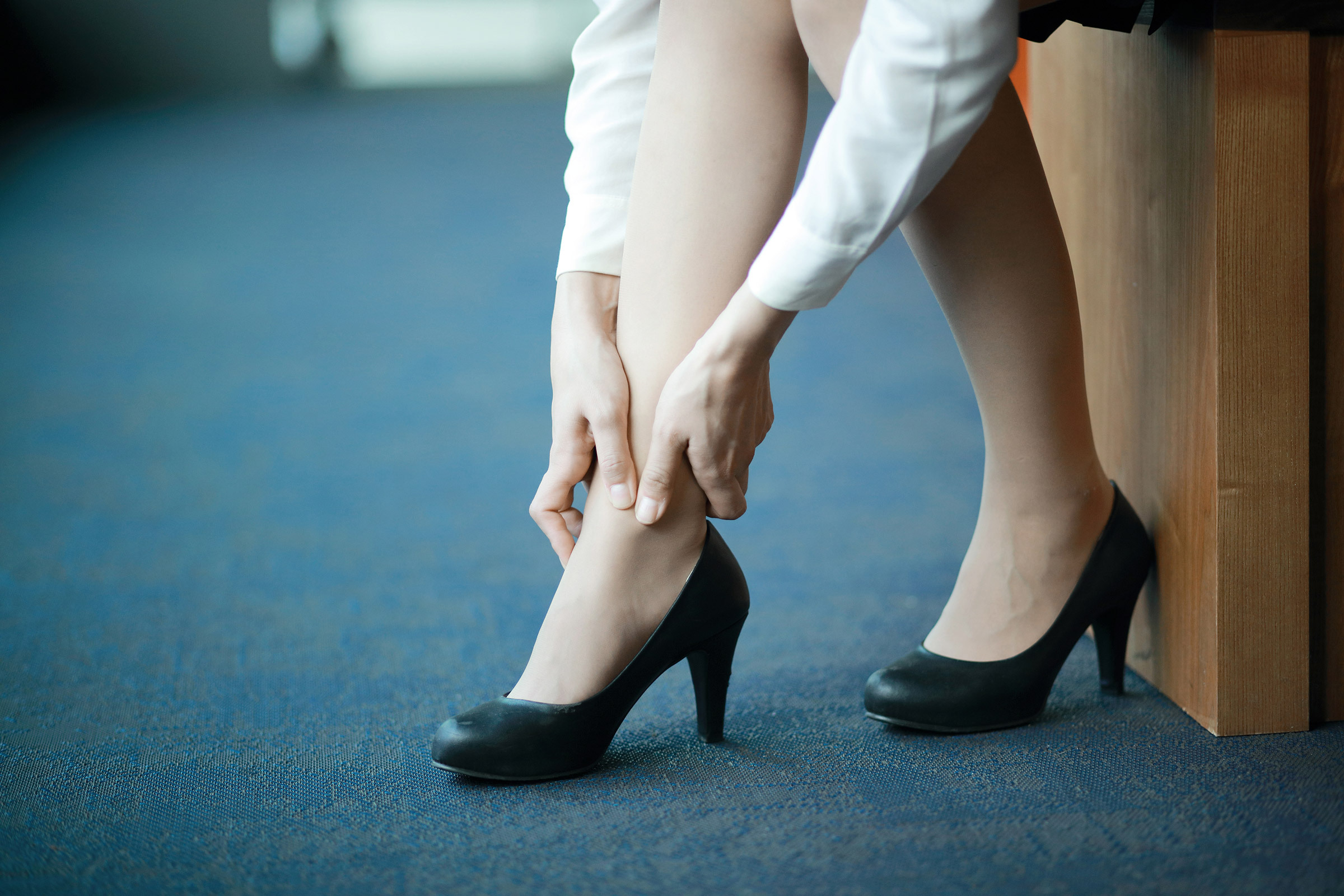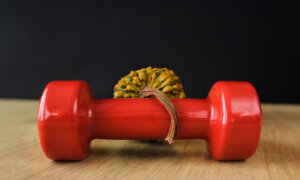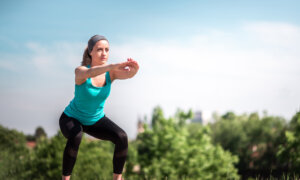Let’s be honest: High heels are timeless and elegant. They’ve stayed fashionable for centuries, maintaining relevance as other trends come and go. When paired with a dress, they create an instantly classy look.
However, high heels, especially those with significant elevation, can strain the muscles, joints, and ligaments of the lower legs over time. Research indicates that the higher the heel, the greater the misalignment of the foot. They can also increase the risk of falls. Oh, the price we’re willing to pay for fashion.
Fashion doesn’t have to be painful. The following exercises can help strengthen muscles and increase joint flexibility, ensuring you look and feel great.
My patients generally tolerate these exercises well, but you may wish to seek medical advice to ensure they are appropriate for you.
5 Exercises for High Heel Pain Relief
1. Calf Stretches
High heels literally keep you on your toes, which places your gastrocnemius and soleus muscles in a constantly shortened state. Simply taking your high heels off at your desk isn’t enough to stretch them out properly. Calf stretches are ideal for providing a deep stretch for these muscles.

(Chung I Ho/The Epoch Times)
Step 1: Stand approximately 3 feet in front of a wall.
Step 2: Step back with your right foot as far as you can while keeping your foot flat on the floor.
Step 3: Place your hands on the wall and carefully bend your arms, moving your head toward the wall while keeping your feet in place and your back straight. Do not bend your knees. You should feel a strong stretch to the back of your right calf.
Step 4: Hold this position for 30 seconds, then rise back to standing. Step your right foot back to the starting position, followed by your left foot, and repeat the movement.
Step 5: Perform the stretch 10 times per leg while listening to your body. The stretch should be strong but never cause excessive pain.
2. Foot Lifts
Standing on your tiptoes all day can strengthen your gastrocnemius and soleus muscles but does little for the muscles on the front of your calves, like your tibialis anterior. Foot lifts can be beneficial in addressing this.

(Chung I Ho/The Epoch Times)
Step 1: You can perform this exercise while sitting or standing, but I often find that sitting is best for beginners. Sit in a chair with your right knee partially extended and your foot resting on a book or other surface that can elevate it above floor level. Place your foot through a kettlebell. I find that a 5-pound kettlebell works best.
Step 2: Lift your foot as high as it can go while keeping your heel in contact with the surface; your knee should remain still. Don’t rush the movement; take approximately 1 to 2 seconds to move your foot through its entire range of motion. Once you lift your foot as high as you can, hold the stretch for approximately 1 second before lowering it back down all the way.
Step 3: This counts as 1 repetition. Try to perform 20 repetitions on both feet per set, and attempt 3 sets.
This exercise provides an excellent workout for muscle groups that are frequently overlooked, serving a crucial secondary purpose: The anterior muscles play a critical role in lifting your foot during walking. Stronger anterior muscles can help reduce the risk of trips and falls by ensuring better foot clearance and stability during each step.
3. Stair Calf Raises
The standing calf raises you did earlier helped stretch out your tight gastrocnemius and soleus muscles. This exercise will help strengthen them by moving them through a full range of motion while also bearing weight. If you can’t find stairs to use, you can use a book, yoga step, or any other stable surface to achieve the necessary height. This approach ensures the muscles are both stretched and strengthened, reducing the risk of muscle imbalances and enhancing overall lower leg stability.

(Chung I Ho/The Epoch Times)
Step 1: Stand on a stair step with your heels hanging off, allowing only your toes to bear weight.
Step 2: Slowly lower your heels as far as your feet and ankles will allow. For stability, it may help to hold onto a railing or wall.
Step 3: Once you reach the bottom of your stretch, slowly rise onto your toes and lower back down. Take approximately 1 to 2 seconds to rise up and then lower back down, which counts as 1 repetition.
Step 4: Try to perform 3 sets of 12 repetitions.
If you find that you can do this exercise easily, feel free to add sets and repetitions. However, for the first time, limit yourself to avoid excessive soreness later. This approach helps build strength gradually, ensuring you do not overexert your muscles and allowing them to adapt to the new exercise regimen.
4. Standing Inversion/Eversion
This exercise focuses on improving side-to-side ankle flexibility, emphasizing both strength and flexibility. High heels, while elegant, can often lead to ankle sprains due to their propensity for turning ankles. Performing this exercise regularly can help prevent such incidents by enhancing ankle stability.

(Chung I Ho/The Epoch Times)
Step 1: Stand with your feet approximately shoulder-width apart.
Step 2: Roll both feet outward so that you’re standing on the outsides of your feet, a position known as inversion. Hold this position for about 10 seconds.
Step 3: Roll your feet back flat onto the floor and continue until you’re standing on the insides of your feet, which is called eversion. Hold this position for 10 seconds before returning to flat feet.
Step 4: Count each movement through eversion and inversion as 1 set. Try to perform 3 sets of 12 repetitions.
Instead of simultaneously moving both feet into either inversion or eversion, you can perform an alternating left/right movement. In this pattern, invert one foot while everting the other, then reverse the movements. This approach may feel more natural for some people, though both methods are effective.
5. Towel Slides
Towel slides offer excellent strengthening and mobility benefits for your ankles, countering the relative stasis experienced when wearing high heels. This exercise focuses more on enhancing flexibility rather than just rote strengthening.

(Chung I Ho/The Epoch Times)
Step 1: Lay a large towel flat on the floor, whether carpeted or a hard surface. Sit in a chair in front of the towel with your knees bent and your feet flat on the ground.
Step 2: Put the toes of your right foot on one end of the towel with your heel on the floor.
Step 3: Using your toes, slide the towel a bit at a time to the right by rotating your foot. Hold your leg as still as possible to maximize foot movement.
Step 4: After reaching the end of the towel, reset it and slide it the other way. Once you have moved the towel in both directions with your right foot, reset the towel and repeat the exercise with your left foot.
The towel will bunch up as you go, but this is expected. Doing the exercise on a carpeted surface will increase the difficulty, which is beneficial if you can handle the extra effort.
To achieve the desired results, try to do these exercises at least three times per week. When performed consistently, they can be very beneficial and help keep you fit for fashion.














